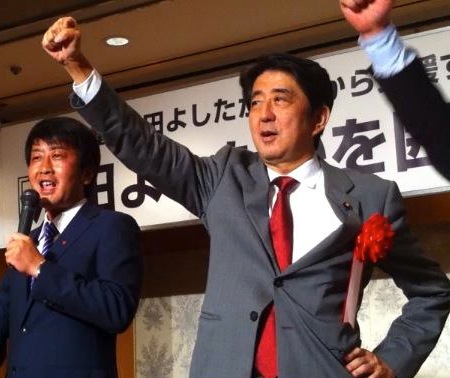Former Japanese prime minister Shinzō Abe has returned to the leadership of the once-dominant Liberal Democratic Party of Japan (LDP, or 自由民主党, Jiyū-Minshutō) after an internal party election Wednesday, paving the way for a rare second act in Japanese politics for the nationalist Abe. ![]()
Abe will likely now lead the LDP into elections in 2013 against the ruling Democratic Party of Japan (DPJ, or 民主党, Minshutō). Although the LDP remains unpopular, polls show that the LDP appear likely defeat the even more unpopular DPJ — that means Abe is now the hands-on favorite to become Japan’s next prime minister.
Abe, who succeeded the wildly popular reform-minded Junichiro Koizumi as prime minister in 2006, was the first of a string of six prime ministers from both the LDP and the DPJ who have followed in the ensuing six years. He served exactly one year before resigning, ostensibly for poor health, but Abe had become increasingly unpopular throughout 2007 following LDP misappropriation scandals (which resulted in the suicide of his agriculture minister) and tumult over Japan’s role in the military action in Afghanistan. Under Article 9 of Japan’s constitution, Japan is prohibited from any act of war, making even a supporting role in the Afghanistan action controversial.
As prime minister, Abe was known for his nationalist stance vis-a-vis China, North Korea and South Korea. That posture has taken on greater significance, with China and Japan now facing off in an increasingly tense standoff over the status of the Senkaku islands (known as the Diaoyu islands in Chinese). The showdown has already led to a massive anti-Japanese sentiment on the Chinese mainland and threatens to destabilize not only East Asian trade and commerce, but also peace throughout the region at a time when both countries are looking to leadership transitions.
Japan’s current DPJ prime minister Yoshihiko Noda is forecast to lose the next general election, which must be held before August 30, 2013. Chinese leaders are likewise focused on a transfer of power within the Politburo Standing Committee of the Communist Party — outgoing general secretary Hu Jintao is set to be succeeded by Xi Jinping, but higher-than-normal turnover is also expected among the nine-member standing committee as well.
Abe is relatively pro-American — the DPJ came into office on a promise (unfulfilled) to close a U.S. military base in Okinawa, a promise (fulfilled) to end Japan’s refueling mission in Afghanistan, and to orient Japan’s foreign policy more toward Asia than to the United States. In addition, Abe has expressed interest in revising Article 9 of Japan’s pacifist constitution in order to allow Japan to have some kind of military force in the future.
In reclaiming the leadership, Abe defeated Shigeru Ishiba, the former chairman of the LDP policy research council, by mobilizing enough factions of the LDP’s Diet members in the runoff, after rank-and-file members (who could vote in the first round, but not the runoff) made clear their preference for Ishiba.
Abe won the backing of three of the five strongest LDP factions, including the Machimura faction (led by former foreign minister Nobutaka Machimura), a nationalist, conservative faction that championed Koizumi and also Abe in 2007 as prime minister and the Nukaga faction (led by former finance minister Fukushiro Nukaga), a more liberal faction that championed former prime minister Ryutaro Hashimoto. He also won a faction led by former prime minister Tarō Asō (who served from 2008 to 2009).
The Koga faction (led by former LDP secretary general Makoto Koga), a more elitist, moderate faction, less enthusiastic about Koizumi, supported Ishiba. Abe named Ishiba as the LDP secretary general following the contest, in a nod to Ishiba’s relatively greater popularity among Japanese voters.
The LDP dominated Japanese politics in much of Japan’s postwar era, controlling the Diet, Japan’s parliament, from 1955 until 2009. In the 2009 general election, the LDP lost control of the 480-member lower house (the House of Representatives) to the DPJ, after having lost its majority in the 242-member upper house (the House of Councillors) in 2007. In the 2009 election, the DPJ and its allies won 320 seats to just 140 for the LDP — at the time a historic rupture in Japanese politics.
But the reality is that the DPJ governments have not been so different from the post-Koizumi LDP governments — the DPJ has gone through three prime ministers since 2009: Yukio Hatoyama served from September 2009 until just June 2010 and Naoto Kan served from June 2010 until his resignation in September 2011, when Nota became prime minister. Like the LDP before it, the DPJ has been undermined by difficulty in passing bills through the Diet, by further government scandals, and a plan to pass an unpopular increase in the national consumption tax at a time when Japan’s economy remains mired in its second decade of low GDP growth. The DPJ has also been criticized for its response to the Fukushima nuclear disaster than followed the March 2011 earthquake and tsunami.

2 thoughts on “Abe returns to lead Japan’s Liberal Democrats in advance of 2013 Diet elections”